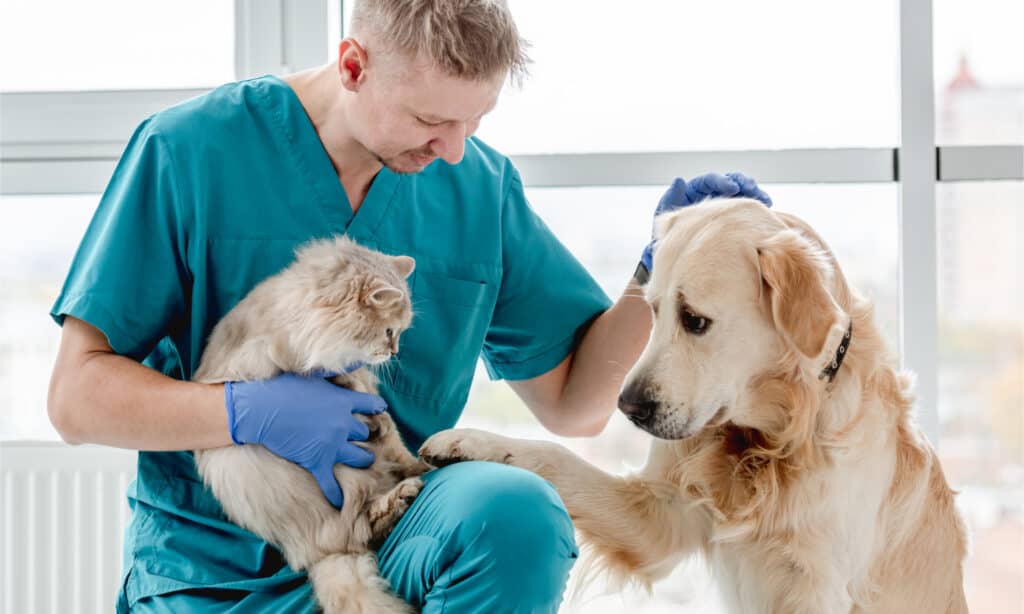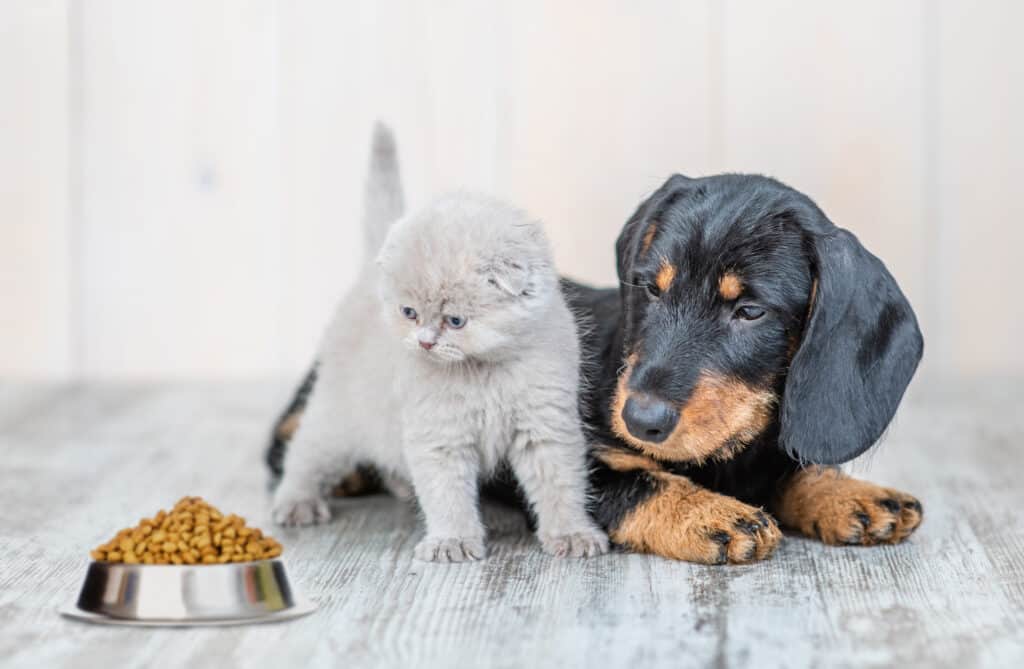Are you considering adding a kitten to your dog-friendly household? If so, you’re not alone. It’s a common challenge many pet owners, researchers, and animal behaviorists have tackled and studied extensively. While the age-old narrative often paints dogs and cats as natural adversaries, reality suggests otherwise. With the right approach, your home can indeed become a welcoming place for a playful feline and pup combination.
This process may seem daunting, but with carefully planned steps and a sprinkle of patience, you can create a harmonious living arrangement that bodes well for both parties. In this guide, we’ll walk you through six important steps for introducing kittens to a dog.

This process may seem daunting, but with carefully planned steps and a sprinkle of patience, you can create a harmonious living arrangement that bodes well for both parties.
©iStock.com/jstankiewiczwitek
Understanding the Basics: Importance of Proper Introduction
When you’re welcoming a kitten into a home with an already established pet, the first introduction is incredibly important. This initial meeting can set the tone for their future relationship. Each animal has its own unique behaviors and communication styles, and understanding these can greatly influence the success of their cohabitation. Dogs, being pack animals, may view the introduction of a new animal into their environment as an invasion of their territory, or alternatively, as the arrival of a new pack member. On the other hand, cats, being more solitary by nature, might perceive this scenario quite differently.
If the first meeting between your dog and kitten is rushed or not well-managed, it can result in unwanted behaviors. Fear, aggression, or avoidance could set in, and these responses can be tough and time-consuming to overcome. Hence, it’s crucial to avoid these situations by ensuring that the introduction process is calm, gradual, and well-controlled.
Step 1: Initial Preparation for Introducing Kittens to a Dog
Dogs, as sociable pack animals, have an innate curiosity and excitement around new creatures, while kittens, though playful, often display caution in new environments and around potential predators. This difference in instinctual behaviors doesn’t spell doom for their potential friendship; rather, it highlights the need for a carefully guided introduction process.
Creating separate, secure spaces for each animal can help reduce stress and ease the introduction process. You should consider designating a spare room equipped with all necessary amenities for the kitten, and for the dog, ensure a comfortable existing area such as a crate or a familiar space. The aim of this initial preparation is to ensure a smooth and stress-free transition for both pets, paving the way for a potential bond to form between them.
Step 2: Familiarizing Your Kitten with the New Environment
Before your kitten and dog meet nose-to-nose, it’s essential to make sure that the kitten feels safe and comfortable in its new home. Think of it this way: you wouldn’t want to meet new people in an unfamiliar place, would you? The same goes for your kitten. Before they meet their newest housemate, they need to get used to their new surroundings.
Start by setting up a separate space for your kitten. You can use a spare room, laundry room, or even a cordoned-off corner of your living room can work. This area should have all of their essentials: a litter box, food and water dishes, a scratching post, and toys. Think of this as your kitten’s safe haven. Here they can get used to all the new smells, sounds, and sights without any stress. When they seem relaxed and confident in their new environment, you can start the process of introducing the dog. Be sure to remember, every kitten is unique, and some may take a little longer than others to feel at home. Patience is key during these introductory steps.

Before your kitten and dog meet nose-to-nose, it’s essential to make sure that the kitten feels safe and comfortable in its new home.
©scaliger/iStock via Getty Images
Step 3: Gradual Scent Introduction for Dogs and Kittens
The introduction process between a kitten and a dog isn’t just a visual experience but also a sensory one. The scent plays a pivotal role in their world. To facilitate a smoother transition, it’s crucial to familiarize your pets with each other’s scent before they physically meet.
The objective of this step is to allow the kitten and dog to get to know each other’s scents without the pressure of direct interaction. This can be done by swapping items between the two. For example, a blanket your dog often uses can be placed in the kitten’s designated area, and vice versa. To take it a step further, you can also rub a soft cloth on your kitten to pick up their scent and then place it next to your dog, allowing them to investigate it at their own pace. You can repeat the same process for the kitten with your dog’s scent.
Pay attention to how both your kitten and dog respond to these scent introductions, noting any signs of relaxation or distress. Once both pets seem comfortable with the other’s scent, you can confidently move on to the next phase, the initial face-to-face meeting.
Step 4: The Initial Face-to-Face Meeting
Once you’ve set the stage with the scent introduction, it’s time to arrange the first face-to-face meeting. This step is important as it’s the first time your pets will physically see each other.
Start by ensuring that your dog has had a good amount of exercise before the meeting. This helps lower their energy levels and promotes a calm demeanor which is vital for the first introduction. For the first meeting, a neutral location within your home is the ideal setting. This is to reduce the chances of territorial disputes.
Your dog should be on a leash, but it’s important to keep it loose enough to prevent causing stress. Your kitten should have the freedom to explore and set the pace of interaction. Kittens might react differently: some may be more curious and approach the dog, while others may prefer to keep a distance. Respect these natural instincts, as they play a significant role in the acclimation process.

Kittens might react differently: some may be more curious and approach the dog, while others may prefer to keep a distance.
©Tatyana Vyc/Shutterstock.com
Step 5: Supervising First Interactions and Monitoring Behaviors
During the initial interactions, both your pets are likely to be on high alert, actively gauging each other’s presence and responses. It’s during these early stages that they start establishing their dynamic. Our task, as responsible pet owners, is to create an environment that enables positive interactions while simultaneously preventing any possible instances of conflict or distress.
You should ensure that the encounters are kept brief in the beginning and gradually extended as your pets grow comfortable in each other’s presence. Make sure your dog is on a leash during these interactions, to ensure that you can quickly regain control if necessary. You should also make sure that the kitten always has access to its safe zone or an escape route, reaffirming that it has control over its movements and interactions.
Careful observation of behavior is paramount during these sessions. Look out for signs of fear, discomfort, or aggression from either pet, such as hissing or growling, flattened ears, or stiff body language. If you observe any of these signs, it’s best to intervene and give both pets some time to relax before attempting another interaction. Some pairs might adjust quickly, while others might take a bit more time. By offering a safe and patient space for them to interact, we can nurture a positive relationship between our pets, eventually leading to a harmonious coexistence.
Step 6: Establishing a Peaceful Coexistence: Time, Patience, and Training
Establishing a peaceful environment doesn’t happen overnight. It requires time, patience, and, most importantly, consistent training. The focus at this stage is on reinforcing positive behavior and gently correcting any undesirable actions that might occur. One practical method is to reward both pets when they exhibit calm and accepting behavior toward each other. This could be through verbal praise, petting, or treats. Over time, your pets will associate positive experiences with each other’s presence, thus fostering a friendly rapport.
While rewarding positive behavior is important, it’s equally essential to correct unwanted behaviors. For example, if your dog is overly enthusiastic around the kitten, it may frighten the latter. In this case, gently pull back your dog, commanding them to sit or stay. Likewise, if the kitten exhibits signs of fear or aggression, it should be returned to its safe space to calm down.

Establishing a peaceful environment doesn’t happen overnight. It requires time, patience, and, most importantly, consistent training.
©Hryshchyshen Serhii/Shutterstock.com
Troubleshooting Common Issues During the Introduction Process
Despite the best preparations and intentions, introducing a kitten to a dog isn’t always a seamless transition within the home. It’s normal to encounter some hurdles along the way, and it’s crucial to know how to navigate these potential challenges effectively.
Aggression or Fear:
If your dog displays signs of aggression or the kitten seems excessively fearful, it’s a sign to slow down the introduction process. These responses often indicate that one or both pets feel threatened or overwhelmed. In such cases, take a step back and allow both pets to have some space and time apart. Gradually reintroduce them when they are calm.
Over-excitement:
Dogs, especially younger ones, can get overly excited when meeting a kitten, which could scare the smaller and more delicate creature. Teach your dog calm behavior around the kitten, rewarding them when they’re calm and gently correcting them when they get too excited.
Refusal to Eat or Use the Litter Box:
If the kitten refuses to eat or use the litter box, it could be a sign of stress or anxiety. Make sure the kitten’s necessities are placed in a quiet, safe area. If the problem persists, consult with a veterinarian.
Excessive Hiding:
If the kitten spends most of its time hiding, it may still be scared of the new environment or the dog. Give it more time to adjust and make sure it has a safe space to retreat to. Gradually encouraging interaction with the use of toys can help build confidence.
Tips and Tricks to Make the Introduction Easier
Utilizing Positive Reinforcement
Positive reinforcement is a powerful tool in shaping your pets’ behavior. Reward both your dog and kitten with treats, praise, or petting when they behave calmly around each other. This associates positive experiences with their interaction, encouraging more of such behavior.

Feeding your pets at the same time, near each other but still separated, can allow them to associate eating with the other’s presence.
©Ermolaev Alexander/Shutterstock.com
Leveraging Meal Times
Meal times can be utilized to create positive associations between your pets. Feed your dog and kitten at the same time but at a safe distance from each other. Gradually, they’ll start associating the pleasant experience of eating with the presence of the other.
Engaging in Joint Activities
Engage your pets in joint activities like play sessions or relaxing together under supervision. This helps build a bond between them and gets them accustomed to each other’s presence in a fun and relaxed environment.
Thank you for reading! Have some feedback for us? Contact the AZ Animals editorial team.








